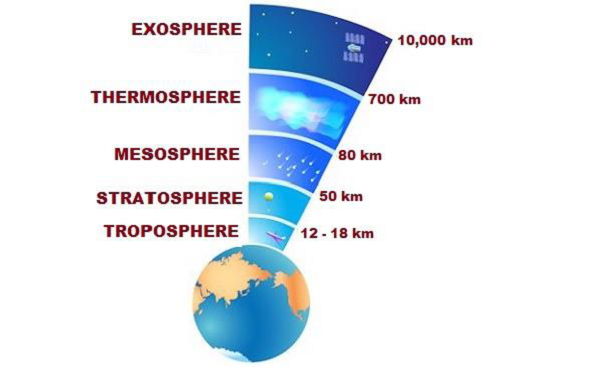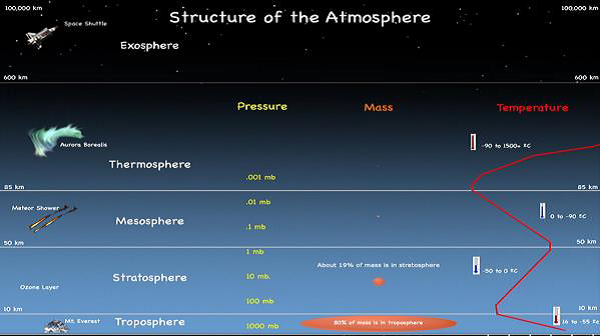
- GK Useful Resources
- GK - Online Quiz
- GK - Online Test
- GK - Quick Guide
- GK - Useful Resources
- GK - Discussion
GK - Structure of Atmosphere
-
The structure of the atmosphere is classified into the following layers −
Troposphere: 0 to 12 km
Stratosphere: 12 to 50 km
Mesosphere: 50 to 80 km
Thermosphere: 80 to 700 km
Exosphere: 700 to 10,000 km
Troposphere
Troposphere is the closest to the Earths surface and contains water vapor (clouds), moisture, dust, etc.
Most of the weather phenomena take place in Troposphere.

Height of the Troposphere varies i.e. at the equator, it is measured about 18 km and at the poles, it is 12 km.
Tropopause is the transitional zone that separates Troposphere and Stratosphere.
Stratosphere
Stratosphere is the second-lowest layer of the Earths Atmosphere that goes up to 50 km.
Stratosphere contains Ozone (O3) Layer that absorbs the ultraviolet rays (coming through the Sun rays) and protects life on the Earth.
As the ultraviolet radiation absorbs in Stratosphere, therefore the temperature rises with increasing altitude.
The Stratopause is the transitional zone that separates Stratosphere and Mesosphere.
Mesosphere
Mesosphere, present above the Stratosphere, extends up to (from 50 km to) 80 km.
Temperature in the Mesosphere decreases with increasing altitude.
Mesopause is the transitional zone that separates Mesosphere and Thermosphere.
Thermosphere
Above the Mesosphere, Thermosphere is the second-highest layer that starts at the altitude of 80 km and extends up to (roughly) 700 km (however, it varies between 500 and 1000 km).
The lower part of the Thermosphere (roughly between 80 km and 550 km) contains ions and known as Ionosphere.
The temperature of the Thermosphere rises with increasing altitude.
Thermopause is the transitional zone that separates Thermosphere and Exosphere.
Exosphere
Exosphere is the highest or outermost layer of the Earths atmosphere that extends (starting from 700 km altitude) up to 10,000 km where it ultimately merges into the solar wind.
Major constituents of the Exosphere are helium, hydrogen, nitrogen, oxygen, and carbon dioxide.
The phenomena of Aurora Borealis and Aurora Australis can be seen in the lower part of the Exosphere (merged with upper part of the Thermosphere).

The Satellite (orbiting the Earth) is normally placed in the Exosphere (as shown in the image given above).